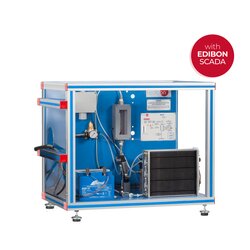Computer Controlled Thermal Solar Energy Unit (EESTC)



PL-298617
The "EESTC" Computer Controlled Thermal Solar Energy Unit is designed to convert solar energy into usable thermal energy using both thermosiphon and traditional pumping systems. This unit utilizes simulated solar radiation from a powerful lamp panel to heat water, demonstrating the principles of solar thermal energy collection.
Key components of the EESTC unit include:
- Thermal Solar Collector: This collector is mounted on an aluminum frame, where water circulates through copper tubes. Its geometrical design maximizes solar energy absorption, enhancing efficiency.
- Accumulator Tank: Coated with an anti-corrosive material, the accumulator tank includes a computer-controlled heating element equipped with a safety mechanism to prevent overheating.
- Solar Simulator: The solar simulator features lamps that emit radiation mimicking sunlight, with a radiation sensor measuring the intensity of this light. The collected light is converted into heat within the solar collector, which then heats the transfer fluid. The simulator can operate in three configurations: all lamps on, half in a zigzag pattern, or a single lamp activated.
- Pumping System: A computer-controlled pump enables forced convection of the heat transfer fluid through the accumulator tank, facilitating efficient heat transfer.
The unit is outfitted with sensors and meters to monitor critical parameters such as temperature, flow rate, and solar radiation levels. Additionally, safety valves are included for overpressure protection.
This unit is integrated with the EDIBON Computer Control System (SCADA), which provides comprehensive control capabilities. It includes the main unit, a Control Interface Box, a Data Acquisition Board, and software for computer control, data acquisition, and process management.
The "EESTC" Computer Controlled Thermal Solar Energy Unit is designed to convert solar energy into usable thermal energy using both thermosiphon and traditional pumping systems. This unit utilizes simulated solar radiation from a powerful lamp panel to heat water, demonstrating the principles of solar thermal energy collection.
Key components of the EESTC unit include:
- Thermal Solar Collector: This collector is mounted on an aluminum frame, where water circulates through copper tubes. Its geometrical design maximizes solar energy absorption, enhancing efficiency.
- Accumulator Tank: Coated with an anti-corrosive material, the accumulator tank includes a computer-controlled heating element equipped with a safety mechanism to prevent overheating.
- Solar Simulator: The solar simulator features lamps that emit radiation mimicking sunlight, with a radiation sensor measuring the intensity of this light. The collected light is converted into heat within the solar collector, which then heats the transfer fluid. The simulator can operate in three configurations: all lamps on, half in a zigzag pattern, or a single lamp activated.
- Pumping System: A computer-controlled pump enables forced convection of the heat transfer fluid through the accumulator tank, facilitating efficient heat transfer.
The unit is outfitted with sensors and meters to monitor critical parameters such as temperature, flow rate, and solar radiation levels. Additionally, safety valves are included for overpressure protection.
This unit is integrated with the EDIBON Computer Control System (SCADA), which provides comprehensive control capabilities. It includes the main unit, a Control Interface Box, a Data Acquisition Board, and software for computer control, data acquisition, and process management.
What is this?
These percentage scores are an average of 0 user reviews. To get more into detail, see each review and comments as per below
If you have used this product, support the community by submitting your review



